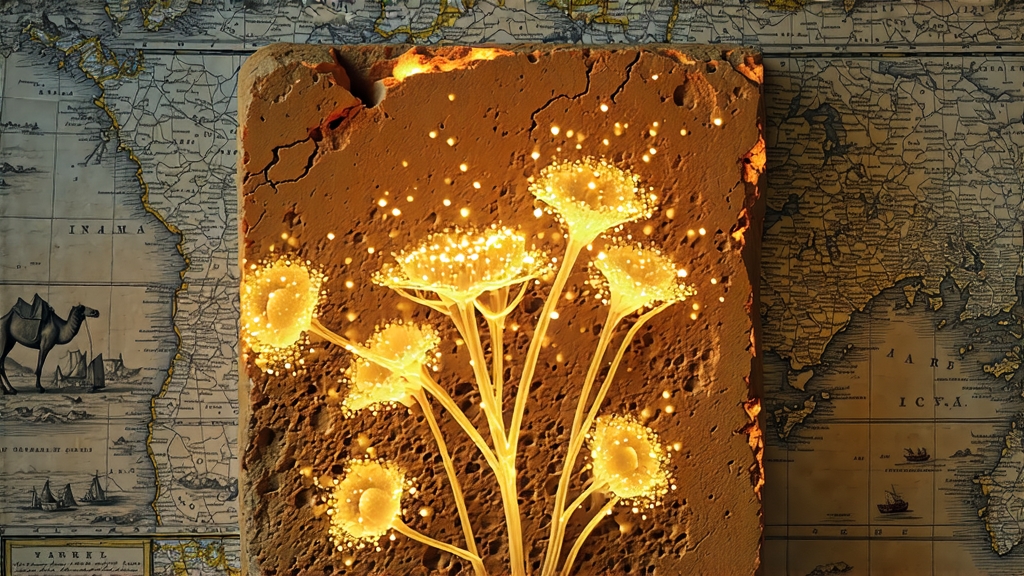
If green tea is the bright youth of Chinese tea culture and pu-erh its brooding middle age, then Fu brick—Fú zhuān—must be the wise elder whose stories are told in dusty caravanserais along the old Silk Road. Compressed into dark, iron-hard blocks, veined with golden mycelium, and mellowed by years of silent microbial song, Fu brick is the most aromatic ambassador of China’s “black” tea family—hei cha—yet it remains almost unknown outside Asia. This essay invites the global tea traveler to taste a slice of history, science and art that begins in the misty Qinling Mountains and ends, centuries later, in your own porcelain cup.
-
A leaf born on the hoof
The tale starts in 1368, the first year of the Ming Dynasty, when the imperial court revoked the traditional “tea-horse” tribute of loose leaves and demanded instead compressed bricks light enough for camel saddles. Caravans leaving the ancient city of Xianyang—gateway to the western deserts—needed a tea that would survive six-month journeys across altitude, frost and scorching sand. Local dark tea, already sun-withered and pile-fermented, was steamed, pressed into brick-shaped molds, and wrapped in bamboo husks. Somewhere along the march the bricks began to bloom with tiny yellow specks that smelled of wet hay and dried apricot. Camel drivers noticed that the farther the caravan traveled, the sweeter and smoother the infusion became. Thus the “Fu” brick was christened: “Fu” from both Xianyang’s Fǔ county and the Chinese word for “blessing,” because fortune literally flowered on the road. -
Terroir: where north China exhales
Today genuine Fu brick production is restricted to an arc of counties along the Wei River in Shaanxi and to the alpine foothills of Yunnan where the same cultivar—Qinmei #3—has adapted to sharp diurnal shifts. The bushes grow at 800-1,200 m on loess terraces whose alkaline soil forces the roots to pull deep minerals, especially selenium and zinc, into the leaf. In late April, after the Qingming festival, only the third and fourth leaves are plucked; their thicker cuticle and higher starch content feed the fungi that will soon embroider the brick. -
Crafting a living brick
Fu brick is not simply pressed dark tea; it is a two-stage fermentation masterpiece.
Step 1: Maocha “rough tea”
Leaves are withered under north-China sun for four hours, then pan-fired at 180 °C for eight minutes to kill green enzymes while preserving leaf integrity. A 24-hour wet-piling follows: the tea is heaped 70 cm high under cotton cloth, moistened to 28 % humidity, and turned every hour so thermophilic bacteria climb to 55 °C. This “wet-pile” is shorter than Yunnan shou pu-erh, yielding a lighter, hay-like base.
Step 2: Jin hua “golden flowers”
The half-fermented maocha is steamed at 102 °C for 30 seconds to soften, then inoculated with Eurotium cristatum spores collected from the rafters of 400-year-old warehouses. Workers pack the tea into hand-carved fir boxes lined with breathable linen; each box holds exactly 2 kg, the weight a camel could balance. For the next seven days the boxes rest in an underground cave whose walls drip with mineral water, maintaining 28 °C and 78 % humidity. Inside, the fungus erupts into star-shaped yellow granules—jin hua—that stitch the leaf fibers together while secreting enzymes that convert polysaccharides into soluble sugars and tannins into the mellow pigment theobromine. When the brick is finally unmolded it smells of pine pollen, honey and old parchment.
- The many faces of Fu
Although all Fu bricks share the golden-flower signature, three styles have emerged:
- Shaanxi Classic: 1 kg rectangular brick, 20 % stems, aged 3 years minimum; liquor is tawny amber with a camphor note.
- Hunan Tianjian Blend: lighter 500 g “book” brick using Yuntaishan leaves; sweeter, orchid finish.
- Yunnan Alpine Mini: 100 g coin pressed for urban millennials; faster flower growth at high altitude gives a mango-like top note.
Each style is stamped with the dynasty-era